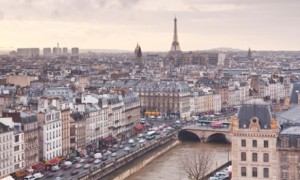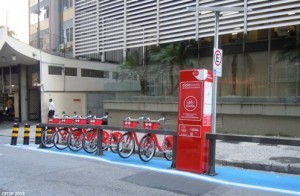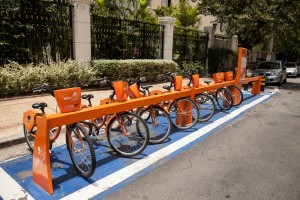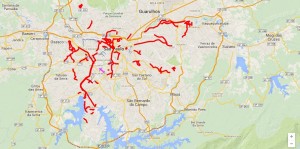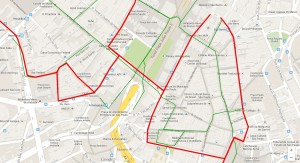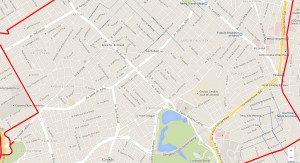It is a common understanding today that the public transport needs to be the majority of the kinds of transportation in a city. In a first moment a metro line or the renewal of an old infrastructure of public buses may appear expensive, but through the long therm, they represent a lower impact on the environment, demands lower maintenance and promote a more civic city.
Said that, it is important to understand that as a more civic city is our objective, we should increase the value of peoples decisions over their lives, and since with all the information that we already offered to people, some of them still believe that the private transportation is the best for them. In this scene, the use of the city streets become a representation of the city’s life, and it is its most public space.
Jane Jacobs wrote at “The Death and Life of Great American Cities” (1961) that streets “serve other purposes besides carryng wheeled traffic in their middles. Streets and their sidewalks, the main public places of a city, are its most vital organs.”
Understanding one important lesson of economy will be useful to understand why the majority of cities in the world will not be totally free of cars in the next years: If someone can choose between two things to consume, they will always consume what in their minds in good for them. So it is not difficult to understand that in some countries where the infrastructure of the city public transport system is bigger and well manteined (western europe countries and japan) people use less cars, and countries in which the private transport receives a big amount of invesments (North America) and countries which the public transport system poorly exist (South America and Eastern Europe), the private way of transport is the major used among the others.
Presenting what is happening in São Paulo (Brazil), this article pretends to show a way of a non planned union between the Private and Public Sector to increase the use of bicycles in this city without any form of pushing the users to do this by punisment and spending almost any public money, just urban planning.
At the beggining of December 2014, the Paris mayor announced plans to ban diesel cars from the French capital by 2020 as part of an anti-pollution drive. Anne Hidalgo also said parts of central Paris would severely curtail private car use by creating semi-pedestrianised zones, beginning with an experiment on weekends which could be “rapidly” extended to include weekdays. Vehicle use inside these zones would be limited to the cars of residents, and emergency and delivery vehicles.
Source: http://www.theguardian.com/world/2014/dec/07/paris-mayor-hidalgo-plans-ban-diesel-cars-french-capital-2020
São Paulo is the major city in Brazil. In its metropolitan area lives more than 11 million people and the city has the largest economy by GDP in Latin America and Southern Hemisphere. But besides of its wealth, as other mega-cities in emergent economies, the city has a lot of unequal healthy and underdevellopped infrastructure, which causes a very difficult life for the poorest, since they do not have a easy access to public services, and forces the ones who have the economical power, to get those services by the private sector. This situation occurs in the public transportation also. In the last decades of Brazil, the private transportation have been understood as the mainly method of transportation, and also as a way of economical development by the growth of the car industries. Hopefully this idea has started to change since the end of the military dictatorship (primary a right wing government).
The “Elevado Costa e Silva”, built in the 70′s by the military dictatorship, crossing a central residential area in downtown was at the beggining received as a wealth signal and later became a reason for degradation of the area. Their demolishment started to be seriously discussed by the city major at 2006, and again by the current mayor, both from different political parties.
Source: http://wikimapia.org/12916395/pt/Elevado-Presidente-Costa-e-Silva-Minhoc%C3%A3o
During the last three decades, NGO’s started to appear in São Paulo trying to aware the popullation for issues like preservation of the enviroment, public participation on politics of cities, use of bicycles, among others. Those NGO’s ttogetherer with the spread of information from the press about those issues made some segments of the society (usually higher-medium segments) tried to respond in a positive away about those questions. Those people started to consume more ecological and social responsable products. Sooner, companies started to capitalize and became, at least apparentaly, more ecological and social responsable. One of those segments were the banks, who saw an opportunity to gather a more positive and up-to date image among young and rich consumers. Those banks made a system of renting bicycles for a couple of minutes for free, and charge for a little value if the user rides more hours, but you could only use this service if you are a client of those banks. At begining those stations for renting bicycles were instaled in a very few areas and only in rich neighborhods of the city to atract those young rich consummers. Those stations started to function as a unique way of advertisement of the banks, since public advertisement are extremely controlled in São Paulo. Sooner they realized that those stations could function not only as a way of self promotion, but also as a little source of income and due to the good reception, those banks installed those stations in different parts of the city. The idea of a bicycle as a way of transportation achieved a status of ‘possibility’ in the minds of the rich popullation, who were using them during the weekends.
Images of the two stations of the different banks. The first one is from Itaú in, the program started at 2012 and is called Bike Sampa (http://www.bikesampa.com.br/app/), and the other was Bradesco, who started the Ciclo Sampa in 2013 (http://www.ciclosampa.com.br/), both of them with the suport of the cityhall, but made and controlled by the banks.
In 2013 the current mayor of São Paulo started a big program that would deliver 400km of bicycle lanes to the city (http://www.cetsp.com.br/consultas/bicicleta/400km.aspx), which already have built 78km at September 2014. At the beggining the population was extremely against this program, but later gained more than 80% of aproval (http://g1.globo.com/sao-paulo/noticia/2014/09/datafolha-80-aprovam-ciclovias-em-sp-aumenta-popularidade-de-haddad.html). Those lanes were installed and planed by the public sector, and different from the private, started on the downtown area and spread fast to reach more distant regions, mainly by poorer people. Today those lanes are not only used by poor people, but by everyone. The government is still installing the lanes which are used as a way of transportation and as a hobby during the weekend. Also, developed a small station similar to the ones of the banks, but continue working together with the banks to install the first ones.
Map of the current bicycles lanes of the city: 1- in all over the city, 2- in downtown and at 3- a maily rich area.
Source: http://vadebike.org/2014/07/mapa-ciclovias-sao-paulo-ciclofaixas-ciclorrotas/
In conclusion, it is clear that the car is still the major way of transportation among the rich people, since the most rich neighborhoods are the ones with the fewest amount of lanes in the city, and the ones in which the program is the most unpopular. But also, it was because of those rich regions that those banks installed those stations. Both of them functioned in a coexistence way. Both of them could exist without each other, but they become more effective together. The stations were the initial step on this coexistence, their job was to gather public awareness to the transport issue and were done by the private sector and are the most efective way of charging. The lanes in other hand, is an infrastructure in the city, it is very cheap to be installed, but could only be installed by the public agent and since there are no eficiant way of charging people for using it, it is perfect to achieve the poor regions. They represent a balanced existence between two sectors, none of them took the right of the car to share the city, and shows a economic sustainability change in the city, made without a center agent, but with all agents working together: Society, Public Sector and Private Sector.

